
Container gardening is a versatile and practical way to grow your own vegetables, especially root vegetables. Whether you have limited space, poor soil quality, or simply want the convenience of tending to your plants on a smaller scale, container gardening offers a solution that can yield bountiful harvests. In this article, we will delve into the secrets of successful container gardening for root vegetables, providing you with essential tips, techniques, and insights to help you grow a thriving garden right at your fingertips.
Choosing the Right Containers
The first step in successful container gardening for root vegetables is selecting the right containers. When it comes to root vegetables, depth is crucial as they require ample room for their roots to grow. Opt for containers that are at least 12 inches deep, with a minimum width of 12 inches. This will provide enough space for the roots to develop and prevent overcrowding.
Additionally, consider the material of the containers. Clay pots offer excellent drainage but can dry out quickly. On the other hand, plastic or wooden containers retain moisture better. Ultimately, choose containers that suit your specific needs and preferences.
Selecting the Ideal Soil Mix
To ensure the optimal growth and development of your root vegetables, it is vital to select the right soil mix. Most root vegetables thrive in well-draining soil that is rich in organic matter. Aim for a soil mixture that consists of equal parts of garden soil, compost, and perlite or vermiculite for improved drainage.
Before planting, ensure the soil is adequately moist but not waterlogged. This will provide a favorable environment for the seeds or seedlings to establish themselves and encourage healthy root growth.
Picking the Perfect Location
When it comes to container gardening, the location plays a crucial role in the success of your plants. Most root vegetables require at least six hours of direct sunlight per day to thrive. Therefore, select a location that receives ample sunlight, such as a patio, balcony, or sunny windowsill.
Additionally, consider the temperature requirements of your chosen root vegetables. Some may prefer cooler temperatures, while others thrive in warmer conditions. Understanding the specific needs of your plants will help you choose the ideal location for their growth.
Choosing the Right Root Vegetable Varieties
There is a wide variety of root vegetables to choose from, each with its own unique flavors and growth requirements. When selecting the right varieties for container gardening, consider the size of the mature plant and its root system. Opt for compact or dwarf varieties that are well-suited for container growth.
Popular root vegetables for container gardening include carrots, radishes, beets, turnips, and parsnips. Each of these vegetables offers a different taste and texture, adding diversity to your culinary adventures.
Planting Techniques for Success
To maximize your chances of success, it is important to follow proper planting techniques. Start by filling your container with the prepared soil mix, leaving a few inches of space at the top. Sow the seeds according to the recommended depth and spacing for each particular vegetable.
If you prefer to start with seedlings, gently transplant them into the container, ensuring the roots are well-covered by the soil. Water the newly planted seeds or seedlings thoroughly and maintain consistent moisture throughout the growing season.
Watering and Fertilizing
Proper watering and fertilizing are essential for the health and productivity of your root vegetables. Water your container garden regularly, ensuring the soil remains evenly moist but not waterlogged. Overwatering can lead to root rot, while underwatering can stunt growth and result in small or bitter-tasting vegetables.
For optimal growth, consider using a balanced, slow-release organic fertilizer. Apply the fertilizer according to the package instructions, taking care not to over-fertilize. Regularly monitor the health of your plants and adjust watering and fertilizing practices as needed.
Harvesting and Storage
The moment of anticipation finally arrives when it’s time to harvest your root vegetables. Root vegetables are typically ready for harvest when they have reached their mature size and have developed vibrant colors. Gently loosen the soil around the base of the plant and carefully lift the vegetables from the container.
After harvest, it is important to store your root vegetables properly to maintain their freshness and flavor. Many root vegetables can be stored in a cool, dark place such as a cellar or refrigerator. However, some varieties, like carrots and beets, benefit from removing the tops before storage to prevent wilting.
Conclusion
Container gardening for root vegetables opens up a world of possibilities for gardeners of all skill levels. By following the secrets shared in this article, you can create a thriving container garden that yields a bountiful harvest of flavorful and nutritious root vegetables. Remember to choose the right containers, select the ideal soil mix, pick a suitable location, choose the right vegetable varieties, follow proper planting techniques, and maintain proper watering and fertilizing practices. With dedication, care, and a touch of green-thumb magic, you can uncover the secrets of successful container gardening for root vegetables and enjoy the fruits (or rather, vegetables) of your labor. Happy gardening!